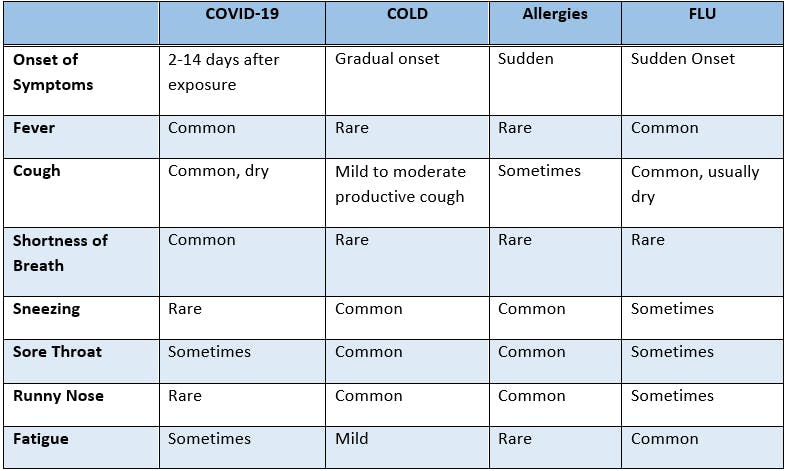What are the Symptoms of the Coronavirus Compared to the Flu

COVID-19, the novel coronavirus first observed in humans in Wuhan, China, in December, 2019, has caused a modern-day pandemic, spreading disease rapidly from person to person into every corner of the globe.

The number of cases in the US is rising exponentially and, chances are, you or someone you love will get sick or, at the very least, be exposed to this highly contagious virus. It’s important to understand the basics about COVID-19.
What is COVID-19 and Who Gets It?
COVID-19 is one member of a large coronavirus family. There are seven identified coronaviruses that infect people; the rest infect only animals. Four of the seven human coronaviruses are as common as the common cold and you’ve probably never even heard of them. But three coronaviruses are well known; MERS, SARS CoV, and SARS CoV -2, also known as COVID-19. SARS, MERS, and COVID-19 are all infectious respiratory diseases, and, while they share much in common because they are cousins in the coronavirus family, they are also very different from one another. Most of the differences are only significant to epidemiologists and infectious disease experts; for our purposes, the differences that matter are that COVID-19 is more contagious and more easily spread that MERS or SARS and that it’s also much less lethal in the general population.
This combination explains the rapid spread of the disease; infected individuals unaware that they have COVID-19 are still highly contagious and are spreading the disease. COVID-19 spreads from person to person easily via microscopic droplets coughed or exhaled from the nose or mouth that are either directly breathed in by other individuals or that land on nearby surfaces.
For most of the population, this is annoying but not really a problem, as COVID-19 will feel like a bad cold. But, for certain high-risk groups, COVID-19 can be lethal. Keep in mind that COVID-19 is very new and what we know about this disease and its risks is changing every day. With that in mind, here’s what we do know so far from the CDC:
- 8 out of 10 deaths in the U.S. have been in adults over the age of 65
- Over 30% of adults over 65 have required hospitalization
- 6-29% of adults 85 years old and older have been admitted to the ICU
- 11-31% of adults 65-84 years old have required admission to the ICU
Other high-risk individuals such as pregnant women, heart and lung disease patients, and immunocompromised individuals are also experiencing high rates of hospitalization as a result of respiratory complications from COVID-19.
Your risk for contracting COVID-19 depends largely on your exposure to the disease. Where you live and where you and your close associates have been has the biggest impact on your exposure risk.
What Are the Symptoms of Coronavirus COVID-19?
COVID-19 is a respiratory illness. Its three main symptoms are mild to severe fever, dry cough, and shortness of breath and these symptoms can appear anywhere from 2-14 days following exposure. COVID-19 shares a number of common symptoms with other respiratory disorders such as flu, colds, and allergies. There’s no foolproof method besides a test to accurately distinguish between coronavirus versus flu or other respiratory problems, but the following are a few key distinctions that can help:
- Fever is a hallmark of COVID-19. If your respiratory symptoms are not accompanied by a fever, you’re likely experiencing allergies or a cold.
- Runny noses and drainage are not associated with COVID-19. If you have a mild to severe fever and lots of gunk in your nose and throat, chances are that you’re in the middle of a cold or the flu.
- Common colds rarely cause fever, almost never cause shortness of breath, and have much milder coughs when compared to COVID-19.
- While the flu comes with fever and a cough, it also almost always also comes with body aches, chills, fatigue, and bad headaches, symptoms that are not strongly associated with COVID-19
Even with these distinctions, it can still be difficult to make a diagnosis without a test. A critical factor is assessing your individual risk for exposure to COVID-19.
IMPORTANT
If you’re experiencing any respiratory symptoms and your risk of exposure to COVID-19 is high, stay home and contact your healthcare provider.

What Is the Treatment for Coronavirus?
If you’ve ever been sick with a virus, you know that treatment options are limited and that’s true for COVID-19 as well. COVID-19 is not caused by a bacteria so it will not respond to antibiotics and antiviral medications targeted to COVID-19 have not yet been developed. Treatment options include remedies designed to ease symptoms. Serious illness occurs when infection sets in; these secondary, serious infections are treated with antibiotics and other medications.
What Can Be Done to Prevent Getting COVID-19?
Prevention is key to slowing the spread of COVID-19.
Know How it Spreads
- COVID-19 passes most often from close person-to-person contact (within 6 feet) but can also spread via contaminated surfaces
Protect Yourself
- Maintain your distance from others
- Wash your hands regularly using soap for at least 20 seconds
- Avoid touching your mouth, nose, or eyes with your hands
- Clean and disinfect regularly touched surfaces daily
Protect Others
- Stay home if you are sick
- Wear a facemask when around others
- Keep your hands clean and your tissues in the trash
Getting Help When You or a Loved One Has COVID-19
As this pandemic spreads, your personal contact with COVID-19 will increase. Follow the guidelines provided by the government and the CDC to isolate yourself and your family to avoid exposure. Call your physician if you are at risk and begin to show symptoms. If you or a loved one contract COVID-19, the caregivers at 24 Hour Home Care are here to help. 24 Hour Home Care provides compassionate, well-informed care to patients requiring home care for any reason; from dealing with the complications of aging to caring for COVID-19 patients, our caregivers have the right skills to provide comfort, care, and relief.
